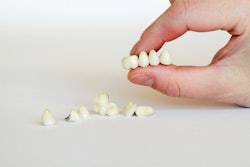
A stronger resin composite might be possible thanks to a polymer used to strengthen car bumpers and protect wood decks. A new filling material with thiourethane demonstrated up to twice the strength of a typical composite in a recent study.
 Carmem Pfeifer, DDS, PhD. Image courtesy of OHSU/Kristyna Wentz-Graff.
Carmem Pfeifer, DDS, PhD. Image courtesy of OHSU/Kristyna Wentz-Graff.Thanks to their aesthetics, dental composites have become an increasingly popular choice of filling material. However, composites only last about a decade, and researchers are looking for ways to improve their strength and fracture resistance.
Senior study author Carmem Pfeifer, DDS, PhD, and colleagues put their idea for using thiourethane to the test in a study published in Scientific Reports (February 19, 2019).
"Today's dental restorations only last seven to 10 years before they fail," stated Dr. Pfeifer, an associate professor of restorative dentistry at the Oregon Health & Science University (OHSU), in a press release. "They crack under the pressure of chewing or have gaps form between the filing and the tooth, which allow bacteria to seep in and a new cavity to form."
Improving strength, reducing viscosity
Previous research has already established that dental composites become stronger with the addition of thiourethane. However, formulations with this polymer tend to be thicker, posing clinical and scientific challenges. Dr. Pfeifer and colleagues wondered whether silanization, a chemical process that improves a composite's ability to bond with other components, might keep thiourethane's strength while also reducing excess viscosity.
To find out, they created six experimental thiourethane filling formulas, which they put through a silanization process. They then measured these fillings' strength and viscosity against a commonly available barium glass composite (Premise, Kavo Kerr) in both silanized and unsilanized forms.
The addition of thiourethane made the resin composites significantly more resistant to fractures and stress, the researchers found. The experimental formulas also had comparable viscosity and strength to regular glass composite.
While the thiourethane formulations bested or were comparable to typical composite in all the tests, the degree of improvement varied among the formulas. Those with tetrafunctional thiols (PETMP) performed better on fracture toughness but worse on stress resistance than those with trifunctional thiols (TMP). The researchers hypothesized that this occurred because PETMP molecules have more bonding points, which may make the resulting structure stiffer.

"In general, the results of this study demonstrate that the incorporation of thiourethane silanized fillers into resin composites led to increased conversion at faster rates than the control, while increasing fracture toughness and reducing stress polymerization," the study authors concluded.
From the lab to the clinic
The researchers did not report any shortcomings on their study, although it can be said that these results are not yet clinically relevant since the new filling material is still in the early stages of being created and tested.
Dr. Pfeifer and colleagues are currently conducting a follow-up experiment to test how well these thiourethane formulas resist caries-causing bacteria. They hope their work will eventually lead to stronger composites in the dental clinic.
"Stronger dental materials mean patients won't have to get fillings repaired or replaced nearly as often," Dr. Pfeifer stated. "This not only saves them money and hassle but also prevents more serious problems and more extensive treatment."



















